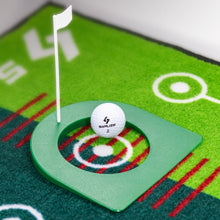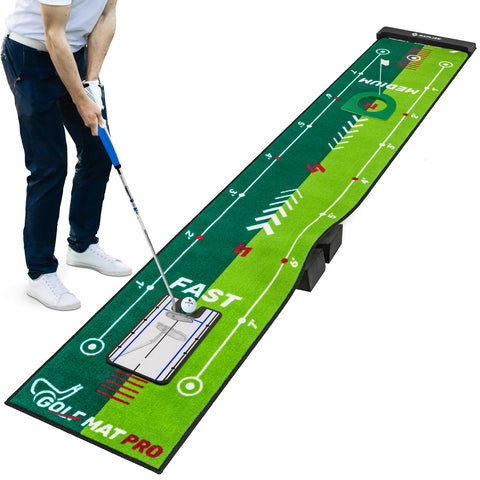A guide to practicing golf at home
Many of us are likely to be investing more time in the house than ever. To help many of you keep busy, I produced an overview of various ways to exercise golf in the house. I'll focus on three significant categories-- putting, Sweeping, as well as wedge play. Not everyone will have the capacity to service every one of these due to size constraints, yet I hope you'll get some good ideas with whatever techniques you can exercise. Additionally, I've connected to various other posts I have written to help explain certain principles in even more detail.
Putting
While you might not make each practice approach, I'll lay it out. Golf Putting is the one thing that practically any individual can exercise in your home.

There are three crucial placing abilities:
- Speed control
- Green Reading
- Beginning the round on your designated line (stroke quality).
Sadly, you can not exercise every one of them in the house. For most of you, your best option is most likely to be dealing with the top quality of your stroke.
What You Can Use
I put a glass on the hallway carpet when I was a teenager. There's nothing wrong with a basic approach like this. If you have an existing surface and want to give yourself more challenges, you can go for a fun, relatively inexpensive golf putting mat.
The Distances That Make a Difference
Practicing your putting inside of 10 feet is very crucial. These are the distances where golfers have a decent chance of making putts.
I typically raise these stats to provide people viewpoint on putting and its problem:
Utilizing these percents as a standard can help benchmark your progress. There are a lot of various games you can play to maintain yourself engaged, and difficult for you to construct your placing abilities. Below are a couple of you can experiment with:

Align six rounds about a foot apart. If you make the first putt, move on to the following one. Each time you miss, you need to start around again. See if you can make it to the last putt. To add an obstacle, you can keep going with the smaller hole or add to the variety of putts you need to make on each station (2, 3, or 4 straight).
A variation of this video game is to slightly alter each round's position (moving it to the left or right) to require yourself to re-align before the next putt.
Choose a range and see how many putts you can make in a row. Have a leaderboard to watch your most acceptable scores from each range.
If You've Got Some Room
Allow's say you do have a stretch of carpet that is longer than 10-20 feet in your house, probably in your basement; you might do some speed practice. While a rug isn't the ideal surface, it's better than nothing!
A great way to work with your speed control is to make a small hole to land the round. For example, if you're just 10 feet away, you can attempt to maintain the ball within a 6-12 inch area (you can use golf rounds or coins to mark these out). As you get better away, claim to 20 feet, you can increase the window to 18-36 inches based on your skill level. Try to challenge yourself with games where you have to land a certain quantity of rounds within the target area before you can move backward.
Practicing Into a Net
Low Point Control
Among the most significant difficulties of exercising on synthetic grass is knowing where your club is bottoming out. Often, mats can offer you an incorrect feeling of self-confidence.
A critical skill of any round demonstrator is low point control. Preferably, you want your irons to contact the sphere first, and after that, interact with the turf later on a downward trajectory. Unlike common belief, you don't require to "hit down on it" that much; most golf enthusiasts would certainly benefit from a reasonably shallow angle of assault with their irons.
Launch Monitors
You can use your phone to record the moment you hit the ball on video so you can find out what went wrong.
Wedge Play
If you have a lawn at your home and are willing to wreck the grass a little bit (don't state I didn't alert you), there are plenty of methods to develop your wedge game. Considering that your lawn dimension will undoubtedly be a constraining element, you will likely be working on much shorter chip or pitch shots.
There are three skills to practice, which mainly decide success on the golf course.
- Distance control
- Trajectory
- Turf interaction
Distance Control
How well you can land the ball within your designated range is probably one of the most vital wedge abilities. If you can land on the green and keep it there, with regularity, you will overcome one of the most significant obstacles in golf-- stopping bogeys and double bogeys. Of course, you want to conserve pars regularly; however, avoiding wedge shots that don't make it on the green is a skill within every golf enthusiast's reach.
So whenever you are hitting wedge shots in your lawn, constantly have a designated target. It could be a tree, a bucket, or perhaps a baseball cap. If you want to put pressure on, put among your children out there and attempt and land the ball; accept them (I'm kidding). Overall, you can't develop your distance control unless you proactively attempt to land the ball within a reasonable distance around your target. Additionally, don't anticipate perfection.
I likewise favor simpleness when it concerns wedge play. Obtain proficiency at managing your range with only one or more wedges, so you recognize what to anticipate on the course. I do 95% of my practice on these shots with my 56-degree and 60-degree wedges.
Lastly, you should mix your method between repetitive and arbitrary targets.
Pick one target and hit 5-10 balls continuously, paying close attention to the overall distance. Track your progress and also obtain affordable with yourself.
Play a game of "leapfrog." Hit the first shot to a shorter distance, and after that attempt, land the next series of spheres one step further than the last. You can also do this backward order.
Arbitrarily test on your own. Establish 4-5 targets around your backyard at numerous ranges and arbitrarily cycle via them.
Trajectory
How low or high your wedge shots travel through the air is vital for scoring. As you have discovered, a shot on a lower trajectory often tends to turn out much more on the green, whereas a higher-lofted shot will undoubtedly stop a little faster.
There are two primary means to control your trajectory without obtaining too tricky. The first is with club selection. All points being equal, chipping with an 8-iron will undoubtedly obtain the ball on a lower trajectory than a sand wedge. The second way to regulate trajectory entails how you provide the club. Some players are much more experienced using their hands and established to add or decrease loft space with the same club.
I believe loft control is a location of wedge play where a little experimentation can help most gamers. What I like to do is pick a target and also attempt to land the ball at the very same range with a low, medium, as well as high trajectory. You can do this with the same club and experiment with ball position, opening up or shutting the face, or changing your method. Conversely, you might additionally pick different clubs to achieve those different trajectories. Going through this exercise will offer you a far better feeling of what's called for to maintain the ball a little lower or higher.
My only caution is that you do not require to get too expensive with points. Generally, you can hit remarkably similar wedge trajectories and get great results on the course. Phil Mickelson flop shots aren't needed. However, experimentation is a valuable workout to develop your abilities, which will undoubtedly make you more efficient on your "stock wedge shots."
Turf Interaction
Another crucial wedge skill is reading your lies. Not every ball will be resting entirely in the fairway. When your ball lands in the rough, you'll be taking care of a range of lies ranging from hidden to being "cozy" as well as in addition to the yard. Your method and also club option need to adjust accordingly.
Your lawn might endure a little, yet if you are willing, you can try out various lies and see exactly how the club reacts. A general rule of thumb to go by is the following:
If your ball is buried, it's ideal for getting a little steeper with the distribution of the club. Think about it like an airplane that is taking a nosedive. Likewise, use a club with even more loft space and bounce (like your sand wedge). You wish to restrict the amount of time the golf club interacts with the yard because it will reduce your club down and turn the face, making it more challenging to control range and trajectory.
Alternatively, if your ball is laying up well in addition to the yard, you can do the contrary. Rather than the fictional aircraft making a steeper descent, you can make a more shallow method to the ball, like a gentle landing on the path. Sometimes, I consider it a lot more as a placing stroke and simply carefully rock my upper body to and fro without engaging my hands a lot.
This is one more location of wedge play where trial and error pays off. Offer yourself a range of lies, and see precisely how slightly changing your technique or club option can change your results. When you exist with those lies on the course, you'll have a better understanding of how the ball will undoubtedly react, as well as just how to play those shots.
Ultimate Home Golf Simulator Guide with 10 Best Indoor Golf Simulators
At-home golf training product recommendations
Golf skill improvement requires not only theoretical knowledge but also ongoing training. Using professional equipment can make golf training more exciting and efficient
Putting Training Equipment:
Putting Mat with Ball Returner
Hitting&Chipping Training Equipment:




